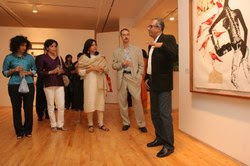
By Rupali Arora
An orange and black warrior goddess wraps a red and gray buffalo demon in a lethal embrace, looking violent and sexual, divine and mortal.The painting of the fifth-century mythical Hindu goddess sold for $1.5 million at a Christie’s auction last year. Created by the contemporary Indian artist Tyeb Mehta, the “Mahishasura" was bought by Rajiv Chaudhari, a private art collector and a New York hedge fund manager.
Art connoisseurs enjoy Indian contemporary artist Atul Dodiya's work at the recently opened Bodhi Art gallery in New York. (Courtesy of Bodhi Art gallery/CNS)
It was the first time that a modern Indian painting fetched more than $1 million.
Indian contemporary art, until recently a somewhat obscure genre outside the Indian subcontinent, is now hot in the global art world. The impact of globalization has sent both the volume and prices of Indian art soaring on world markets.
But buyers are driven more by a desire for financial gain than artistic appreciation.
Many of the buyers are young investment bankers who have been by recent corporate scandals and shaky stock market returns to look for alternative investments like fine art and wine.
“These investors hope that art fund returns are uncorrelated with the stock market,” said Vik Mehrotra, CEO of Venus Capital Management, a hedge fund in Boston. “The contemporary art market in India is growing at 100 percent every year for the last five years,” he said. “It is still undervalued, and Indians are generating a lot of wealth with the economy booming.”
Veronica Collins, a specialist in contemporary Indian art at Christie’s, supports that view. Asia's economic renaissance and the ability of Indian nationals to purchase and support art on the same scale as Western collectors are contributing to the recent boom in Indian art, she said.
“If one thinks about the sheer numbers--that one-sixth of the world's population is from the subcontinent--then it seems their recent popularity is much overdue,” Collins said.
Last year, art connoisseur Prajit Dutta, owner of Arts India, the largest Indian art gallery in the Western Hemisphere, started an art fund in the United States after raising $4 million from 16 wealthy Indians living in America.
“The fund is now worth $9.5 million,” Dutta said. “The returns have been embarrassingly high.”
An art investment fund is more like a private equity fund, Dutta said. It is based on a simple buy low, sell high practice. The company buys art that is undervalued directly from sources in India, keeping in mind the quality of the artist’s work and accessibility issues. It also buys from secondary sources like collectors and auctions.
Inspired by the success of his first fund, Dutta launched another one in April. That fund, worth $15 million, has already appreciated in value.
Initially Dutta saw no competition in the art fund market. Now several similar funds are emerging out of India. However, the United States provides a unique advantage to art fund managers. While India is bogged down with banking regulations and restrictions on capital transfers, Securities and Exchange Commission rules allow for more financial flexibility in operating such a fund in the United States.
“Indian art is being taken very seriously in the West,” said Caren Talwar, director of a new gallery in New York called Bodhi Art. “It’s a trend we can all ride on.”
Lotus art gallery in Austin, Texas, is doing a robust business, with paintings selling from $2,000 to $15,000, says owner Francis Tung. “The art is not just being bought by Indians,” Tung said. “It is an interesting East-West mix."
Venus Capital recently acquired a 5 percent stake in India's leading art auction house, Osian's. According to Mehrotra, people looking to invest in Indian art should be aware of the artists and their works along with historical auction prices. They should know all the players and galleries in the field.
Since paintings by the Indian masters are in short supply, the current focus has shifted to the next generation of artists, who are in their 30s and 40s.
“The collector base for Indian art has been growing as well and there is a much larger demand than supply for the works of a relatively small group of Indian artists,” Collins said.
Yet skeptics of the art fund business are keeping their distance.
“Five years ago I was approached to form [an art investment fund] but stayed away,” said Madhu Garg, a private art collector and corporate legal consultant in New York. “I feel the pool of people actively buying and selling now is small, and that makes me unsure that this art market is sustainable for a fund.”
And the risks are high. Like hedge funds, art funds seek out the “quality investor,” those who can show that they can suffer the loss of substantial investment without being ruined financially.
India’s new wealth will help fuel art prices in the future, so it is reasonable to assume that art prices will continue to go up in India, Mehrotra says. Yet art funds have limited liquidity, and they appeal to a limited set of wealthy investors.
“They may not become mainstream as the investors need to have some risk appetite," he said. “These are suitable for the affluent and institutional investors only.”
Garg does not look at her eclectic collection as an investment. She bought works by popular artists and some younger emerging artists because she liked them. In hindsight, however, she regrets not having bought more when they were affordable. That would have made for a good investment, she says.
Collins says that while works of art can be viewed as good investments, "the best reason to purchase a work of art is not for placement in a fund but for veneration and love of the work itself.”

No comments:
Post a Comment